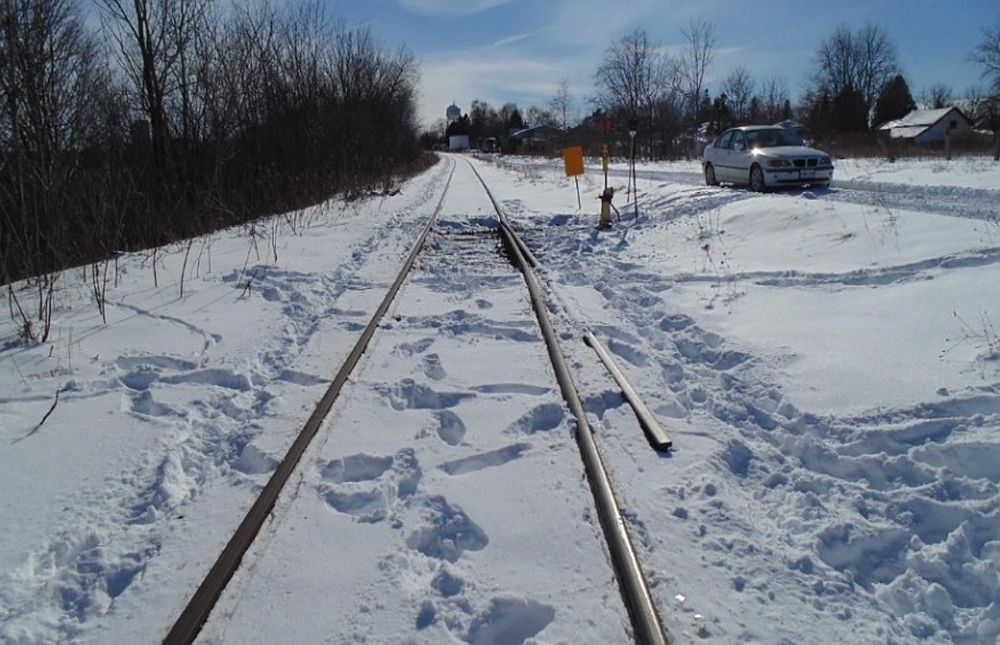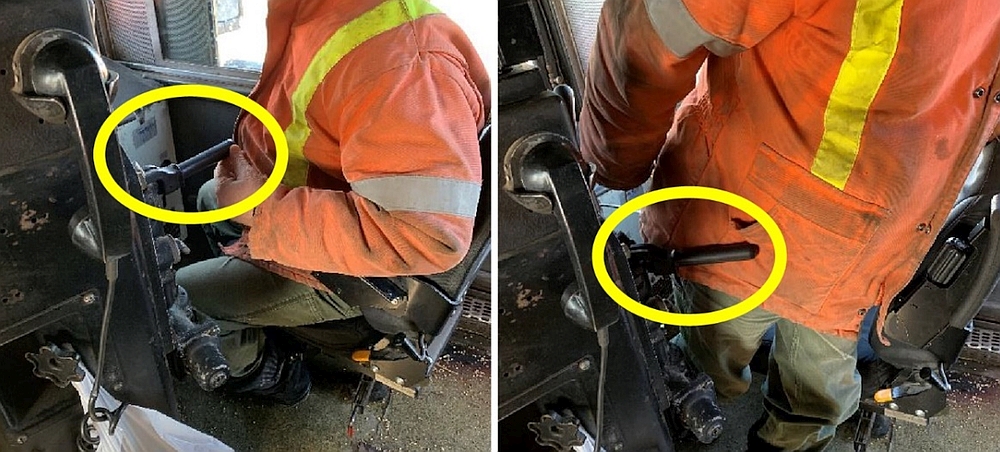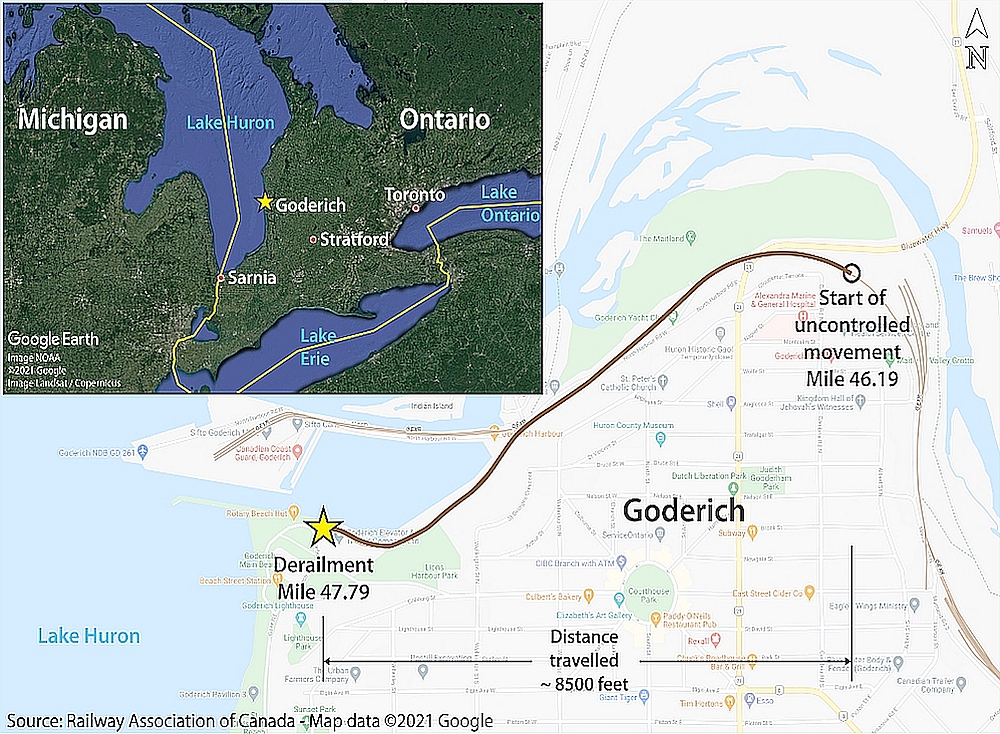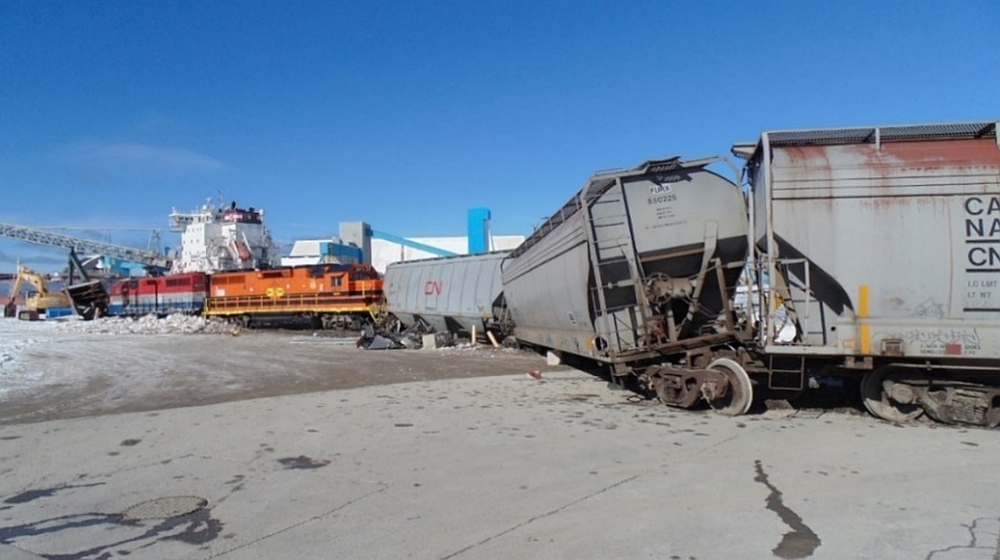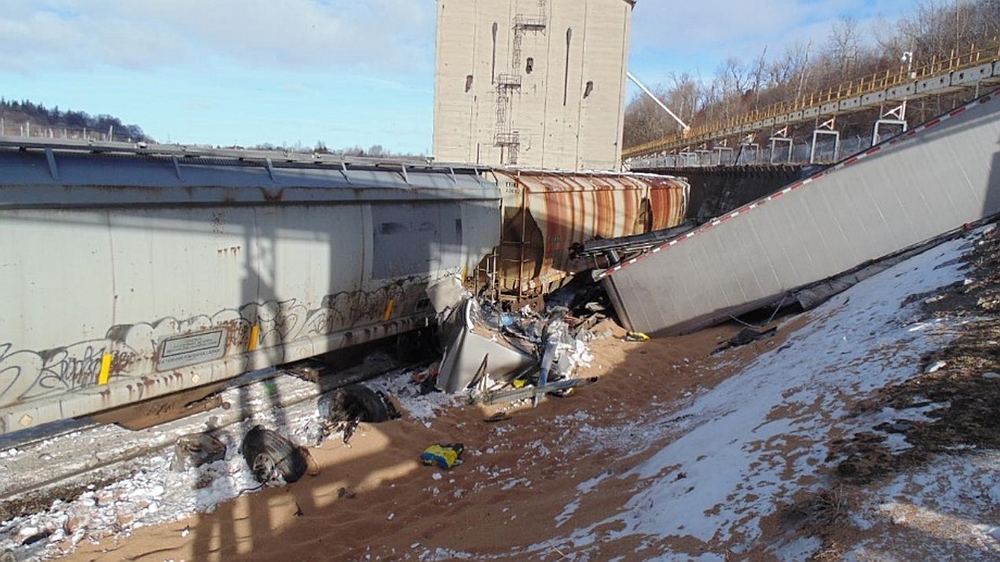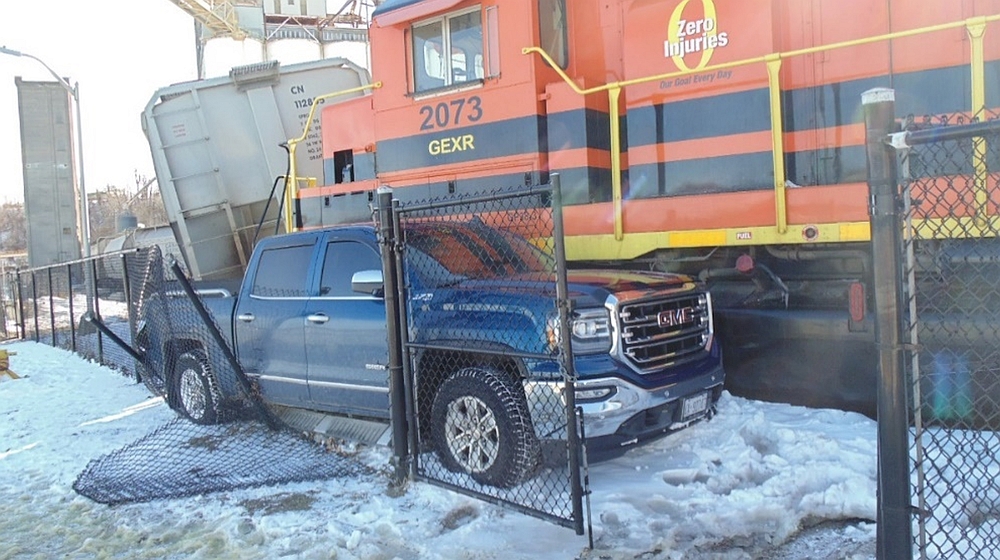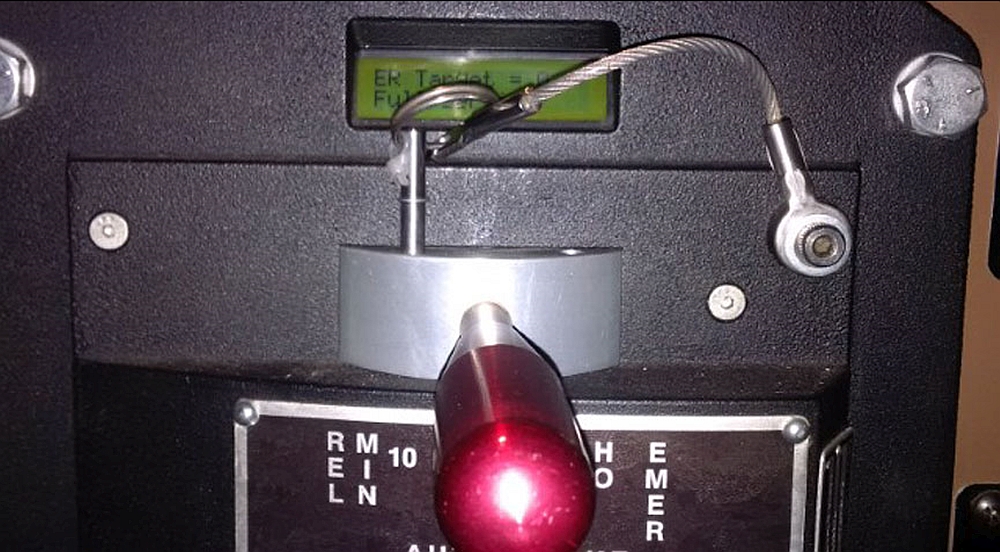Uncontrolled movement resulting in a non-main-track train derailment
Goderich Exeter Railway
Train 581-01
Parrish & Heimbecker Limited elevator facility at the Port of Goderich
Mile 45.9, Goderich Subdivision
Goderich, Ontario
The Transportation Safety Board of Canada (TSB) investigated this occurrence for the purpose of advancing transportation safety. It is not the function of the Board to assign fault or determine civil or criminal liability. This report is not created for use in the context of legal, disciplinary or other proceedings. See Ownership and use of content. Masculine pronouns and position titles may be used to signify all genders to comply with the Canadian Transportation Accident Investigation and Safety Board Act (S.C. 1989, c. 3).
The accident
On 01 February 2021, a Goderich Exeter Railway (GEXR) operating crew was ordered for 0830Footnote 1 in Stratford, Ontario, for train 581-01. The train comprised 2 head-end locomotives and 33 covered hopper cars (14 cars loaded with peas and 19 empty cars). Including the locomotives, the train was 1746 feet long and weighed 2603 tons. The crew consisted of a locomotive engineer (LE) and a conductor, both of whom were qualified for their positions, met fitness and rest requirements, and were familiar with the territory.
The train was a road switching assignment that operated weekly from Stratford to Goderich, Ontario, in order to deliver cars to customers in the area, which included the elevator facility at the Port of Goderich (the facility). Although the facility is primarily serviced by trucks, it handles rail traffic 2 to 3 times per year and was scheduled to receive covered hopper rail cars from GEXR on the day of the occurrence.
At approximately 1325, the train arrived at the west end of Goderich Yard. Given the length of the train, the crew had planned to divide the train into 2 sections, place each section into separate yard tracks, then move the locomotives around the cars to the east end of the yard. From the east end, the locomotives were then to be coupled to the cars and the train was to be shoved westward, down to the elevator. This was a normal procedure for a train of this length.
The route westward from Goderich Yard to the facility is a descending grade that ranges from 1.5% to 2.78% between Mile 45.88 and Mile 47.48 as the elevation drops about 150 feet over a distance of about 1.6 miles. The track ends within the facility.
Upon arrival at Goderich Yard, the conductor detrained to be in a position to handle the track switches when the train was shoved eastward back into the yard and doubled over onto 2 yard tracks. With the conductor on the ground, the train continued westward. The LE made a full service air brake application of the train automatic brakes and fully applied the locomotive independent air brakes.
At 1328:29, the train came to a stop at Mile 46.21, about 100 feet from a split switch derailFootnote 2 located at Mile 46.19 (Figure 1), on an area of track that had an average descending grade of 1.75%.
The LE contacted the conductor on the radio and stated that he was detraining to remove the derail so that the train could be pulled further west to give them enough room to shove it back into the yard to complete the switching. As the LE got up from his seat, he accidentally contacted the automatic brake handle and moved it from the fully applied position to the release position (Figure 2).
At 1328:34 the train automatic brakes began to release.
The LE exited the cab without realizing that the train automatic brakes had been released. The independent brakes of the 2 locomotives remained applied but could not hold the train.
TSB braking calculations confirmed that the full independent brake application on both locomotives did not have sufficient force to hold the 2600-ton train on the descending grade where the train was stopped.
Once on the ground, the LE walked ahead to the split switch derail, removed the derail, and lined the switch for the intended movement down to the facility.
At 1329:16, as the train began to move uncontrolled, the conductor managed to apply hand brakes on the last 2 cars of the train in an attempt to slow the movement, but the train continued to accelerate.
After lining the switch for the movement, the LE turned back toward the train and realized that it was moving and coming toward him. As the train passed by, the LE attempted to board it, but was unable to do so. The train continued to accelerate and, unknown to the facility authority, went through a gate and entered the facility.
The train crew were aware that GEXR track maintenance personnel were working within the facility. They radioed the maintenance personnel and warned them of the approaching uncontrolled movement. The maintenance personnel were able to line switches in advance of the train to route it into a clear track (MD 76) that ended within the facility, in an effort to minimize further damage.
At 1331:42, the train had reached a speed of 27 mph.
After travelling about 8500 feet, the uncontrolled movement derailed at 1331:46, off the end of track MD 76 as the grade levelled out. The train came to rest within the facility, about 345 feet past the end of the track, just short of Goderich Harbour on Lake Huron (Figure 3).
Site examination
Site examination identified that the 2 locomotives and the first 4 covered hopper cars loaded with peas derailed with all equipment remaining upright (Figure 4).
As the train rolled uncontrolled, it struck an unoccupied 18 wheel tractor-trailer loaded with 38 tons of grain that was parked on a crossing within the facility. Both the tractor and its trailer were destroyed and the grain was spilled on the ground (Figure 5).
After derailing, the 2nd locomotive struck a half ton pickup truck that was parked in an adjacent parking lot. As the pickup truck was struck by the train, it was pushed up against a fence which trapped the 2 occupants inside the cab (Figure 6).
Emergency services were able to cut down the fence and free the occupants without further incident.
After derailing off the end of track MD 76, and just before stopping, the train struck and destroyed a large unoccupied wooden shed.
There were no injuries reported as a result of the accident.
At the time of the accident the sky was clear, conditions were dry, and the temperature was −5 °C.
Facility information
The facility is owned and controlled by Parrish & Heimbecker Limited. The private facility is gated and access for both trucks and trains is controlled locally. The rail entrance to the facility is also gated, and train access is only by permission from the facility personnel once the train has left the yard. This usually allows for both rail and truck traffic to be safely coordinated and managed while within the facility. Train speed within the facility is 5 mph.
Locomotive information
Both locomotives were built by General Motors Electro-Motive Division (EMD). The lead locomotive (RLK 4095) was a model GP40 built in 1966 that had not been rebuilt or remanufactured. The trailing locomotive (GEXR 2073) was a model GP38-3 built in 1967 that was rebuilt in 2016. Both locomotives were equipped with a reset safety controlFootnote 3 (RSC) as required by the Transport Canada–approved Railway Locomotive Inspection and Safety Rules.
Neither of the locomotives’ RSCs were equipped with roll-away protection that activates when a predetermined speed is detected, nor were they required to be. Furthermore, the automatic brake handle on the lead locomotive did not contain a locking pin that could provide additional securement of the automatic brake handle, a feature that is found on many newer locomotives (Figure 7).
Previous occurrence involving an automatic brake handle moved inadvertently to the release position
The TSB investigated a previous occurrence in which an automatic brake handle was moved inadvertently to the release position.Footnote 4
In that occurrence, on 29 November 2016, southbound Canadian Pacific Railway (CP) ballast train BAL-27 arrived and parked in a siding with the train automatic brakes and locomotive independent brakes fully applied. Just before exiting the cab, the LE went between the locomotive control stand and the LE seat to retrieve an item and inadvertently moved the automatic brake handle to the release position. Shortly thereafter, the automatic brakes of train BAL-27 released, which left only the locomotive independent brakes on both locomotives to hold the train.
About 2 minutes later, train BAL-27 began to roll uncontrolled at a speed of about 1 mph and subsequently struck a freight car on northbound CP freight train 293-28, which was stationary on the main track at Mile 138.70 of CP’s Weyburn Subdivision. Although both locomotives on train BAL-27 were equipped with functioning RSCs and roll-away protection, the uncontrolled movement was moving too slowly to activate the roll-away protection.
TSB Watchlist
The TSB Watchlist identifies the key safety issues that need to be addressed to make Canada’s transportation system even safer. Unplanned/uncontrolled movement of railway equipment is a Watchlist 2020 issue. As this occurrence demonstrates, unplanned/uncontrolled movements of rail equipment continue to create high-risk situations that may have serious consequences. The TSB will continue to monitor and assess occurrences that involve uncontrolled movements.
Safety action taken
Goderich Exeter Railway
On 05 February 2021, GEXR issued Bulletin No 002-2021, which stated in part that “[e]ffective immediately, Locomotive Engineers operating in Goderich Yard are prohibited from exiting the cab of locomotives to perform other than functions that are directly related to Locomotive Engineers.” That same day, Transport Canada (TC) issued a notice to GEXR to acknowledge the action taken.
Transport Canada
On 12 February 2021, TC issued a letter of non-compliance to GEXR for equipment that was not left properly secured as per Rule 112 of the Canadian Rail Operating Rules.
On 10 March 2021, TC issued 2 ministerial orders (MOs) pursuant to the Railway Safety Act (RSA).
Ministerial Order MO 21-01, issued under section 32.01 of the RSA, required all railway companies and local railway companies listed in the MO to implement safety measures “to ensure that an accident caused by an unintentional release of the air brakes does not reoccur.”Footnote 5
Ministerial Order MO 21-02 was issued under section 19 of the RSA. This MO required railway companies and local railway companies listed in the Schedule of the MO to
revise the Railway Locomotive Inspection and Safety Rules to incorporate design and performance parameters for locomotives with roll-away protection, and to revise the Canadian Rail Operating Rules to develop a precise definition of attended versus unattended equipment as well as incorporate requirements on the use of roll-away protection to reduce the risks of an uncontrolled movement.Footnote 6
This report concludes the Transportation Safety Board of Canada’s investigation into this occurrence. The Board authorized the release of this report on . It was officially released on .
